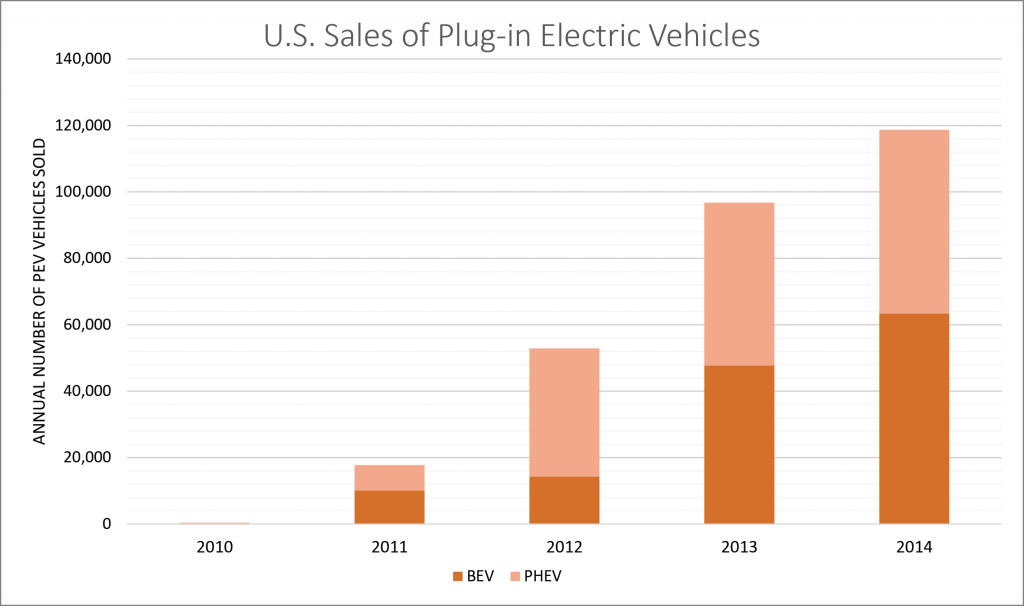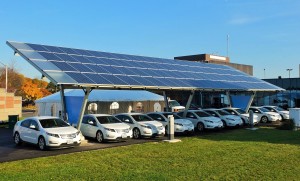Introduction
The energy used to power the motors of electric vehicles is provided by electricity stored in batteries rather than the burning of petroleum-based fuels in an internal combustion engine (ICE). Typically, the vehicle’s batteries are charged by electricity from the electric grid; however, electricity can also be generated wherever the vehicle is being charged from many sources, including from renewable energy, such as wind or solar energy.
There are several types of electric vehicles. The term ‘plug-in electric vehicle’ (PEV) applies to all vehicles that are powered either completely or partially from the electric grid. These can be subdivided into battery [only] electric vehicles (BEV), or vehicles with batteries plus a second power system to extend the vehicle’s driving range after the batteries have discharged. These dual system PEVs are either plug-in hybrid electric vehicles (PHEVs) or extended range electric vehicles (EREVs).
- Plug-in hybrid electric vehicles (PHEV), use their electric motor to supplement a smaller internal combustion engine using petroleum fuel (usually gasoline or diesel). Overall efficiency is improved and petroleum use can be expected to be reduced by about 40%–60%[1].
- Extended range electric vehicles (EREV) employ an on-board electric generator run by a gasoline engine as their supplemental system. The generator continues to supply the car’s electric motor when the battery is depleted.[2]
The difference between EREVs and PHEVs is that EREVs use a petroleum fuel motor to create electricity that powers an electric motor that powers the vehicle, whereas PHEVs use a petroleum fuel motor that directly powers the vehicle. Because of this difference, EREVs are considered electric vehicles by the IRS and may have a higher federal tax credit for consumers than PHEVs. For most consumers, this difference is a technicality and these types of vehicles can be compared based on both the all-electric range and by the mpg after the battery is depleted. By running only on electricity, BEVs must recharge when their batteries are depleted, but they offer the greatest savings on fuel costs, produce fewer emissions than either of the other types, and are eligible for Federal tax credits based on their battery capacities.
Note that the more common hybrid electric vehicles (HEVs) such as the original Toyota Prius, are not plug-in electric vehicles (PEVs). Their electric batteries are charged by energy captured when the vehicle’s breaks are applied or generated by the electric motor while traveling on gasoline power, not from the electric grid. This article focuses on PEVs rather than HEVs. It provides general information, but in this fast developing field, discuss vehicle capabilities and individual needs with a sales representatives for any PEV you are considering for purchase.
PEV Benefits
Electric vehicles offer an array of social, economic and environmental benefits, primarily by reducing the amount of gasoline needed. The specific benefits include:
- Carbon dioxide (CO2) emissions[3] from electricity to power a PEV are reduced by about half from those of a gasoline engine. While an average gasoline car gets about 25 MPG; emissions from electricity generated in Florida are equivalent to emissions of the same gasoline car achieving 51 miles per gallon (about twice the mileage).[4]
- Improved health from reduced soot and nitrous oxides: These are also produced from burning petroleum, causing or aggravating breathing problems for many people.
- Reduced dependence on oil: The U.S. consumes about 20 percent of the world’s oil[5] and about 77 percent of that goes to fuel our transportation system.
- Reduced driving cost for consumers: An average cost for operating an PEV is equivalent to paying $0.98 per gallon.[6] Compared to recent gasoline prices in the range $2 to $4 per gallon, PEVs offer savings of 50% to 75% on fuel costs.
- PEVs are reported to be exciting to drive, due to their quiet, quick acceleration, and their smart, sophisticated features.[7]
Other potential benefits from technologies that are now being developed or are in small scale trial stages include:
- Cost savings for utilities and consumers from optimized timing of vehicle recharging. Ideally batteries should be charged at a time of low demand and excess capacity, and some utilities offer variable rates, so consumers can benefit by charging in the middle of the night when rates are low. Consumers can already delay charging till nighttime, even though they may plug in when they arrive home. However, the ability for utilities to manage charging schedules, allows them to better predict and even out the demand for electricity. A flatter, more predictable load allows the utility to operate more efficiently, from which all their customers can benefit.
- Vehicle-to-Grid (V2G) transfer: A few utilities offer consumers direct payments or discounts on their electric bill if they allow utilities to withdraw some power from plugged in batteries and feed power back into the grid to meet peak electric demands. Utilities must have integrated certain ‘smart grid’ components to allow them to schedule recharging at the most optimal time. There are variations on the way this can work, but participation is always optional, and consumers are compensated for their availability to help supply the grid.
- Vehicle-to-Home (V2H) transfer for emergency power – vehicle batteries may be used to provide emergency power to homes during electricity outages.
More information about these technologies can be found under PEVs and the Electric Grid.
The PEV Market
At present PEV sales are still under 1 percent of all vehicles and lower gasoline prices may lessen the incentive for consumers to purchase electric vehicles.[8] Despite this, sales of PEVs have grown steadily over the last few years as improvements have been made and consumers became more familiar with the technology. From a very modest number in 2010 (345 vehicles) U.S. sales of electric vehicles reached about 120,000 in 2014 (Figure 1), with the cumulative total between 2010 and 2014 reaching approximately 300,000 nationwide.[9]

Figure 2. U.S. Sales of Plug-in Electric Vehicles. Credit: PREC (2010-2013 data)[10] (2014 data)[11]. [Click to view full size image.]
The number of models of PEV available on the commercial market has also grown rapidly, with at least 19 options for PEV on the US market in January 2015 and more expected. Some are luxury/high-performance, sports cars with expensive price tags; others are family sedans, cross-over SUVs or ultra-small, low-cost models intended for basic urban transport. Although buyers can spend more than $80,000 for a new PEV, overall prices have reduced and now almost all models fall in the price range of $25,000 to $40,000[12], a range accessible for a significant number of buyers. A PEV battery is expected to increase the price of a conventional hybrid vehicle by $2,000–$3,000 when they are mass produced, and a 2014 study found that payback periods for the five vehicles they looked at were less than 5 years.[13]
Purchase prices for PEVs are reduced by Federal tax credits of $2,500 to $7,500[14], which can be calculated as $2,500 for an EV with a battery up to 5 kWh, plus $417 per kWh of extra battery capacity, up to a total of $7,500. No additional incentives are currently offered by the State of Florida; but a few utilities offer rebates to their customers for PEV purchases.
With gasoline approximately $2.60 per gallon, electricity to power a PEV costs less than half the equivalent cost of gasoline in Florida.[15] Check the current price comparison. Therefore, even though buyers may pay a premium to purchase a PEV, savings on fuel (and maintenance) can be expected over the lifetime of the vehicle. Electricity to drive a PEV costs only $0.03 to $0.05 per mile, depending on the model. This adds up to a savings of $3,500 to $5,250 in fuel costs over 5 years, as compared to the average 2015 vehicle with fuel efficiency of 24 miles per gallon.[16] Fewer moving parts in electric engines generally mean they also require less maintenance. Some PEVs already have a lower total cost to own than their conventional or hybrid peers.[17]
Challenges
As with most emerging technologies there are challenges to be overcome. With electric vehicles the major concerns for the public are: the higher purchase price compared to an equivalent conventional vehicle, limited range, development of sufficient charging infrastructure, the length of time needed to recharge batteries, and battery reliability. Each of these is being addressed by the industry, and will be discussed below.
Battery Charging
The time required to charge PEV batteries depends on the power source used to charge it, the size of the battery, the type of on-board charger in the vehicle, and even the temperature. There are three primary options for charging a battery.
- Level 1 charging uses a standard 110 volt household outlet (AC—alternating current) for about 11-20 hours to fully recharge a depleted battery, depending upon battery size.
- Level 2 charging requires a 220 volt AC outlet, as commonly used in homes to plug-in washing machines or a 208 volt commercial outlet. (These can either be plugged into an existing 220 volt outlet or a dedicated circuit installed by a licensed electrician.) Level 2 chargers are available for workplace charging and are used in most public charging facilities. An hour of Level 2 charging adds about 15-30 miles of travel capability.
- DC Fast Charging stations are able to charge batteries much faster by using high voltage (480 volt) direct current (DC). It is used for quick charges at public or commercial locations to allow PEVs to travel extended distances, but is not suitable for regular home use. Twenty to thirty minutes of DC Fast Charging is generally sufficient to travel about 80 to 100 miles.[18]
Table 1. Comparison of common PEV charging options
| Charging Option | Power | Equivalent Power Usage | Time to Charge* | Appropriate Use | Applicable Vehicles |
| Level 1 | AC 110-V 15 amps |
Toaster | Up to 20 hours | Home or workplace Regular charging |
All |
| Level 2 | AC 208-220V 20–40 amps |
Clothes dryer | Up to 7 hours | Home, workplace or public locations Regular charging |
All |
| DC Fast Charge | DC 480-V 125 amps |
15 air conditioners | Up to 30 minutes | Public locations Occasional use to 80% of full charge |
Most, type varies by manufacturer |
* Time to charge will vary with battery size, type of charger installed on the vehicle, and battery depletion level.
Plug in connectors for DC Fast Charging were developed with differing designs and are used by different vehicle manufacturers. The first type, CHadeMO, is used primarily by Japanese owned companies. A second type of plug, the SAE Fast Charger (or SAE J1772), is compatible with most American and German designed cars. Tesla vehicles use a third type, known as a ‘Supercharger’. One design may emerge as dominant. Meanwhile, Tesla is developing a network of Tesla only Supercharger stations, and others are developing DC Fast Charging stations that accommodate CHadeMO and/or SAE J1772. Future options may include inductive or Wireless Power Transfer charging that would only require the driver to pull into special parking places to recharge their batteries. Even highways could one day hold embedded wires for induction charging as cars travel over them.[19]
![Figure 3. Level 2, no-cost, public charging in Gainesville, [Click to view full size image.] Florida. Credit: PREC.](https://www.myfloridahomeenergy.com/wp-content/uploads/2015/06/EV-Charging-Magnolia-Park-300x171.jpg)
Figure 3. Level 2, no-cost, public charging in Gainesville, [Click to view full size image.] Florida. Credit: PREC.
Battery expense, reliability and safety
A dramatic decline in the cost of batteries is expected to continue. In 2012 they cost about $500 per kWh, in 2014 about $300 per kWh, and $125 per kWh is expected in 2020.[20] This reduces the cost of a 23 kW battery in a new PEV from about $12,000 (in 1012), to about $7,000 (in 2015), to potentially under $3,000 (in 2020). Battery packs in PEVs are expected to retain at least 80 percent of their charge capacity for 5 to 20 years, depending on conditions including the ambient temperature and various charging practices[21]. Because consumers may feel that the long-term reliability of PEVs are as yet unproven, auto manufacturers are taking on the risk of battery failures or other problems by offering warranties for either eight years or 100,000 miles for most models.[22]
Safety does not appear to be a more significant concern with PEVs than with standard automobiles. The same National Highway Traffic and Safety Administration (NHTSA) standards for conventional cars also apply to PEVs. Safety ratings for electric vehicles from NHTSA and the Insurance Institute for Highway Safety (IIHS) have equaled or improved on those for gasoline engines.[23] In addition, electric systems must meet specific safety standards developed by several organizations. Home and commercial charging equipment undergoes testing by well known, independent laboratories.[24]
Electric Driving Range
The average commuter in the U.S. drives less than 40 miles per day and about 69% travel less than 60 miles per weekday.[25] The current generation of plug-in hybrids (PHEVs) and extended range electric vehicles (EREVs) are most beneficial for those who can match the “all electric” range of the vehicle (currently about 10-40 miles[26]) to their daily travel needs. Energy from the electric grid can typically meet most daily travel, while switching to gasoline allows travel up to 500 miles without re-fueling.
Most existing battery electric vehicles (BEVs) travel about 60 to 80 miles on a single charge; although a few exceed 100 miles, and Teslas are able to travel more than 250 miles, demonstrating the feasibility of longer distances. Swapping vehicles or renting a car on the rare days when extended travel is needed are reasonable options for persons who only make occasional long trips—until the network of charging stations is sufficiently developed to serve their needs. However, this problem may not exist much longer; there are now at least 9,355 public electric charging stations nationwide, including about 500 in Florida[27] and battery electric vehicles with ranges greater than 300 miles are expected in just a few years.[28]
Workplace Charging
The U.S. Department of Energy introduced the Workplace Charging Challenge in 2013, intended to increase the numbers of employers who offer their employees the option to recharge at work, with a goal of 500 employers by 2018. A few measures of its success[29], as of November 2014 are:
- 150 participating employers, offer workplace charging at more than 300 locations.
- More than 5,000 employees of participating companies commute in PEVs.
- About 20 times as many employees of participating companies drive a PEV as in the general public, and 95 percent of employees driving PEVs are satisfied with workplace charging.
- 80 percent of employers give employees free workplace charging.
PEVs and the Electric Grid
PEVs can make renewable energy more effective
It is possible to charge PEVs with photovoltaic solar panels or other renewable sources (Figure 3). Florida requires all utilities to “net meter” solar electricity, which means that customers are allowed to send excess power they generate from renewable sources back into the grid. The excess is credited against their power usage, and they are paid for the difference if they generate more than they use (but at a lesser rate than retail cost).
Solar electricity connected to the electrical grid can be produced during the daylight hours and effectively used during the day or night. For charging stations not connected to the grid, solar power is appropriate for workplace charging during daylight hours, but not overnight charging. Overnight charging can also take advantage of power generated at night from wind, biomass or the utility’s lowest cost, base load power sources. Base load power is generated by reliable, continually operating sources that meet the system’s lowest power needs, as opposed to intermittent and peaking power plants that operate at times of higher power demands.

Figure 4. Vehicles charging with solar power. [Click to view full size image.] Credit: Sass Peress, Renewz Sustainable Solutions Inc., via Wikimedia Commons.
Impact on peak power demand and the promise of Vehicle to Grid
Concerns that continued growth of electric vehicles could negatively impact the electric grid have been expressed. Specifically, concerns are that utilities may have to increase generation capacity if large numbers of drivers arrive home and plug in their vehicles. The impact to the power grid depends on when PEV batteries are charged and what fuel sources are used to generate the electricity.
A 2014 study simulated the effects of integrating large numbers of PEVs and solar photovoltaic electricity and found that uncontrolled recharging could create higher peak demand in the early evening than would have occurred otherwise, but when smart grid capabilities were included to control the timing of PEV charging, the demand was managed without need for increased generation capacity.[30] Workplace recharging and timers to delay the beginning of home recharging are other options to avoid increasing peak evening demand until smart grids can be extended more broadly. Some vehicles already have onboard controls that allow the user to set desired charging times.
In the foreseeable future, new smart grid technologies incorporated with renewable electricity and PEV batteries show promise to actually decrease peak power loads by smoothing out the peaks and valleys of both electricity supply and demand. This involves vehicle-to-grid (V2G) strategies which allow utilities to withdraw power stored in vehicle batteries to meet electric demand on the grid. This balancing of supply and demand could more efficiently incorporate renewable energy sources into the electric grid and reduce peak demands—by 35 percent in one analysis that simulated one-half of gasoline vehicles replaced by PEVs charged by solar power.[31] V2G systems offer utilities the potential to use less expensive and less polluting methods to generate electricity while reducing transportation emissions and costs.
Emergency Power Supply
Vehicle-to-Home (V2H) transfer of power is another possibility under development. When power outages occur on the electric grid, emergency power can be provided to homes by PEV batteries. Vehicle batteries can store a surprising amount of power; a Volt with effective storage of 20KW-hours could run an average household for about 18 hours without any conservation efforts[32] and significantly longer if, for example, power usage were limited to a refrigerator, lights and cell phones. When V2H is tied with a photovoltaic solar system, the solar can provide electricity during grid outages without the need for an expensive and seldom used dedicated battery system.[33]
Electric cars in the U.S. are not currently sold with the inverters needed to enable V2H, but active trials of the technology are underway by the University of Delaware and the Department of Energy. PEVs in Japan were used for emergency power in 2011 and are now being sold with inverters. After Hurricane Sandy, a few enterprising Americans also used their PEVs this way. An inverter adds about $200 to the price of the vehicle.[34]
Conclusion
There are clearly economic and environmental benefits from adopting PEVs as they exist today. We don’t have to wait for future battery improvements or economies of scale in production of PEVs to see life-time cost reductions from driving PEVs. Similarly, a more efficient electric grid and “greener” power from renewable energy sources are not required to see environmental benefits. Even with Florida’s present electric grid and power production, the emissions associated with producing electricity to power electric vehicles are significantly less that the emissions produced by gasoline engines traveling equal distances.[35]
However, full public acceptance of PEVs will require greater consumer familiarity and further expansion of the charging station network. And further development of smart grid and V2G integration technologies is needed to fully realize their potential cost savings and environmental benefits. As these improvements continue and a larger base of satisfied PEV drivers is created, it seems likely that many consumers will decide that PEV benefits outweigh their disincentives.
Further Information
Energy.gov
- eGallon: What It Is and Why It’s Important
- Compare the cost of electricity for an electric vehicle vs. the cost of gasoline, customizable by state. The eGallon: How Much Cheaper Is It to Drive on Electricity?
- Workplace charging, partners and technical assistance: EV Everywhere Workplace Charging Challenge
- Graph of EV sales since 2010 by vehicle model, Visualizing Electric Vehicle Sales
Fueleconomy.gov—Federal Tax Credits for Electric Vehicles by make and model
Electric Power Research Institute
- A Consumer’s Guide to Plug-In Electric Vehicles, (July 2014 report)
- Total Cost of Ownership Model for Current Plug-in Electric Vehicles, (May 2014 report)
Compare vehicles by make and model for efficiency, greenhouse gas and smog ratings.
- DriveClean Buying Guide
- The Institute for Energy Efficiency, CleanCarCalculator.com
- Sacramento Municipal Utility District (SMUD), Calculate monthly fuel cost and CO2 emissions based on customizable gas and electric vehicles and driving needs.
Acknowledgements
Author: Lynn M. Jarretta
Reviewers: Anne-Louise Seaburyb, Colleen Kettlesc, Barry Jacobsond, Christine Swansona
a University of Florida, Program for Resource Efficient Communities
b Electric Vehicle Program, Florida Power & Light
c Florida Solar Energy Center
d Solar Impact, Inc.
Published June 2015.
Footnotes
[1] U.S. Department of Energy, www.fueleconomy.gov, Plug-in Hybrids, accessed June 8, 2015.
[2] Drive Electric Florida, Setting the Record Straight: The Facts About Electric Vehicles, December 2012.
[3] CO2 is the most common greenhouse gas being added to our atmosphere, contributing to global warming.
[4] Don Anair, Union of Concerned Scientists, How do EVs Compare with Gas-Powered Vehicles? Better Every Year…, September 16, 2014.
[5] Office of Energy Efficiency and Renewable Energy, EV Everywhere: America’s Plug-In Electric Vehicle Market Charges Forward, January 22, 2014.
[6] University of Central Florida, Florida Solar Energy Center, 2014, “Did you know?” graphic, accessed June 3, 2015.
[7] Go Electric Drive, A New Driving Experience, accessed June 3, 2015.
[8] Edmunds.com, Inc., from U.S. Department of Energy fuel economy website, accessed March 16, 2015.
[9] David Block and John Harrison, Florida Solar Energy Center, Electric Vehicle Sales and Future Projections, January 2014.
[10] Ibid.
[11] HybridCars.com and Baum & Associates, December 2014 Dashboard, January 6, 2015.
[12] Edmunds.com, Inc., from U.S. Department of Energy fuel economy website, accessed 16 March 2015.
[13] Electric Power Research Institute, Total Cost of Ownership for Current Plug-in Electric Vehicles: Update to Model 2013 and 2014 Model Year Vehicles, 5-20-14.
[14] U.S. Department of Energy, Alternative Fuels Data Center.
[15] U.S. Department of Energy, The eGallon: How Much Cheaper Is It to Drive on Electricity?, accessed 16 March 2015.
[16] US Department of Energy fuel economy website, accessed 16 March 2015.
[17] Electric Power Research Institute, Total Cost of Ownership for Current Plug-in Electric Vehicles: Update to Model 2013 and 2014 Model Year Vehicles, 5-20-14.
[18] Doug Kettles, Florida Solar Energy Center, Electric Vehicle Charging Technology Analysis and Standards, February 2015.
[19] Ibid.
[20] U.S. Department of Energy, EV Everywhere, Battery Status and Cost Reduction Prospects, 26 July 2012.
[21] Mikael G. Cugnet, presentation at the American Chemical Society National Meeting, Understanding the life of lithium ion batteries in electric vehicles, April 10, 2013.
[22] Jeff Cobb, Hybrid Cars, How Long Will an Electric Car’s Battery Last?, April 30, 2014.
[23] Jim Motavalli, Plugincars, Safety Ratings for Electric Cars, January 23, 2014.
[24] Drive Electric Florida, Setting the Record Straight: The Facts About Electric Vehicles, December 2012.
[25] Josh Goldman, Union of Concerned Scientists, Survey Says: Over 40% of American Drivers Could Use an Electric Vehicle, December 11, 2013.
[26] U.S. Department of Energy, Alternative Fuels Data Center, Plug-In Hybrid Electric Vehicles, accessed June 8, 2015.
[27] U.S Department of Energy, Alternative Fueling Station Locator, accessed March 31, 2015
[28] Stephen Vagus, Hydrogen Fuel News, “300-mile range electric vehicles may be on their way”, October 14, 2014
[29] U.S. Department of Energy, Workplace Charging Challenge Progress Update 2014: Employers Take Charge, November 2014.
[30] Fabrizio Fattori, Norma Anglani and Giuseppe Muliere, Solar Energy, Volume 110, Pages 438-451, December 2014, Combining photovoltaic energy with electric vehicles, smart charging and vehicle-to-grid, October 2014.
[31] Ibid.
[32] U.S. Energy Information Administration, How much electricity does an American home use?, February 20, 2015.
[33] Barry Jacobson, Solar Impact, Inc.
[34] 3Antony Ingram, Green Car Reports, Electric Cars Used as Emergency Power: DoD Begins Tests, January 24, 2013.
[35] Union of Concerned Scientists, New Study Shows Electric Vehicles Can Have Significant Climate and Air Quality Benefits Compared to Gasoline Cars, December 17,2014.

![Figure 1. Types of Electric Vehicles. [Click to view full size image.] Credit: PREC.](https://www.myfloridahomeenergy.com/wp-content/uploads/2015/06/Types-of-electric-vehicles-1024x475.png)



